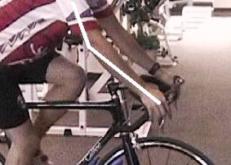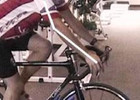How to Fix Neck, Shoulder, and Upper Back Pain When Cycling
Posted by Matt Russ on 24th Oct 2025

Neck and shoulder pain is one of the most common problems cyclists face—especially during long rides or when using an aggressive riding position. Fortunately, this issue is usually easy to solve through a proper bike fit and a few simple technique adjustments.
Why Cyclists Experience Neck and Shoulder Pain
When you lean forward for long periods, your head is forced into a position that isn’t natural. The muscles that support your head and neck are designed for posture—not for heavy lifting. Over time, they can adapt, but the lower your torso is positioned, the more your head extends forward and the harder those muscles must work.
The simplest fix is to ride in a more upright position. However, sitting up too much increases wind resistance and can reduce speed—something most performance-minded cyclists want to avoid. The key is to find the lowest, most aerodynamic position that’s still comfortable for your body.
Start With Saddle Position and Bike Fit
Your saddle position is the foundation of your bike fit. Its placement in relation to the bottom bracket greatly affects your power and comfort. Avoid using saddle tilt to fix upper-body discomfort—handlebar and stem adjustments are better for that.
If your saddle tilts too far downward, your body will slide forward, forcing your shoulders to hold you up. If you constantly have to scoot back, try tilting your saddle slightly upward.
Also, check your bike frame size. A frame that’s too large or too small limits how well you can adjust your position. While bikes have some flexibility in fit, an incorrect frame size will always create problems.
The Importance of Cockpit Setup
A stretched-out cockpit—where the handlebars are too far away—is a leading cause of neck and shoulder pain while cycling. Ideally, your upper arms and torso should form about a 90-degree angle. If your arms reach too far forward, your muscles work harder to support your torso, leading to fatigue and pain.
When adjusting for a more aggressive riding position, make small changes—no more than one centimeter at a time. Gradual adjustments allow your body to adapt without discomfort.
Next, fine-tune your handlebar setup:
-
Adjust bar rotation and control placement for a neutral wrist position.
-
Consider changing to handlebars that are wider, narrower, or have a different drop.
-
Use carbon fiber bars, gel bar tape, or gel-padded gloves to absorb road vibrations and reduce fatigue.
Relax Your Upper Body
Many new cyclists experience upper-body pain simply because they grip the handlebars too tightly. A relaxed grip allows your muscles to stay loose, reducing tension in the neck and shoulders. Remember:
-
Keep your elbows slightly bent (around 10°) and pointing down, not out.
-
Avoid locking your arms—your elbows act as natural shock absorbers.
-
Keep your head and neck in a neutral, relaxed position instead of sinking into your shoulders.
A helpful tip: mark your handlebar’s current position before making small rotational adjustments. You can then fine-tune and easily return to your baseline setup.
If one side of your neck or shoulder hurts more than the other, check your shifter alignment—they’re often slightly off, which can cause asymmetrical strain.
When to Seek Medical Advice
If you experience sharp or persistent pain, stop riding and consult a medical professional. Issues such as a pinched nerve or bulging disc can worsen with continued strain. Take time off the bike and resume only once you’ve identified and treated the cause.
Smart, Affordable Fixes for Cycling Pain
Improving your cycling comfort doesn’t have to be expensive. You can make major improvements with small investments:
-
Swap stems (usually under $100) for better reach and comfort.
-
Adjust your riding form and relax your upper body—it’s free and effective.
-
Increase mileage gradually to let your body adapt and prevent fatigue.
If you typically ride 60–90 minutes comfortably but develop neck or shoulder pain after 3 hours, you may simply be ramping up too quickly.
Key Takeaways
-
Focus on proper bike fit before making posture changes.
-
Make small, incremental adjustments to your setup.
-
Keep your upper body relaxed and elbows slightly bent.
-
Check for uneven handlebar or shifter alignment.
-
Seek medical help for sharp or persistent pain.
With the right adjustments and awareness, you can eliminate neck and shoulder pain—and enjoy longer, faster, and more comfortable rides.
Matt Russ is a professional coach with over two decades of experience working with athletes up to the professional level. His athletes have achieved numerous regional, national, and international titles under his direction. Matt has achieved the highest level of licensing by both USA Triathlon and USA Cycling, and is a licensed USA Track and Field Coach. His accomplishments include being named "Team USA" Coach by USA Triathlon. Matt is Head Coach and owner of The Sport Factory, a USA Triathlon Certified Performance Center located in Roswell, Georgia. Visit www.sportfactory.com for more information or email him at coachmatt@sportfactory.com


